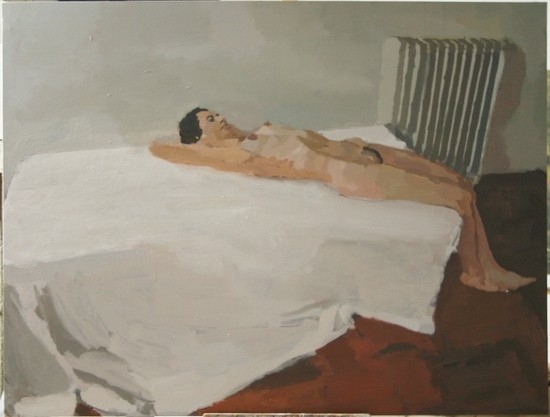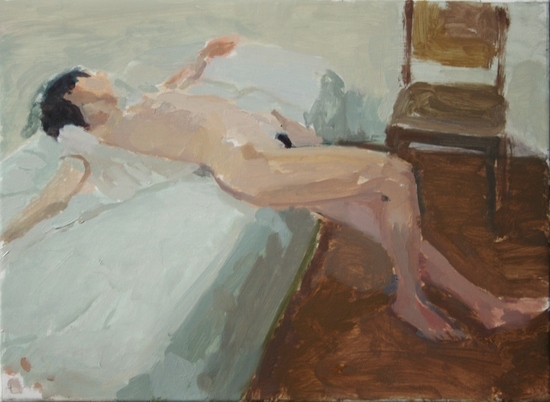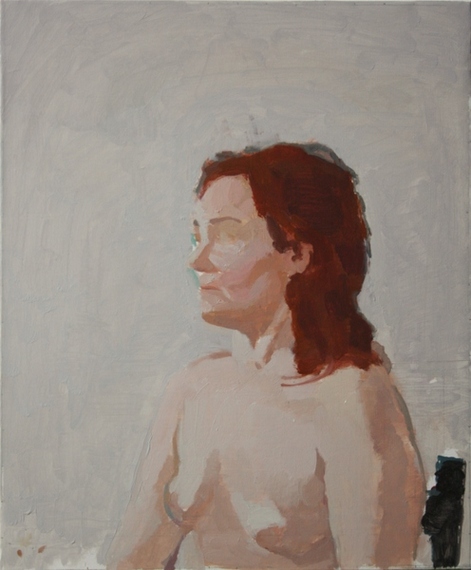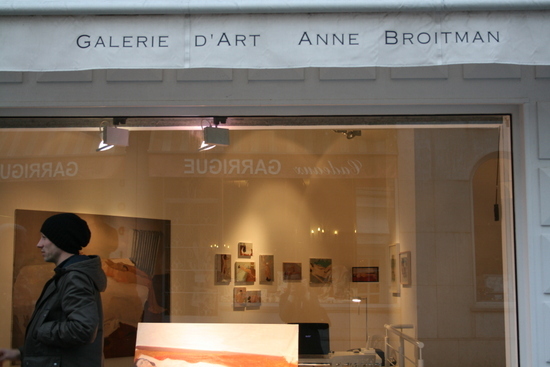Eduardo Alvarado -- a contemporary Spanish artist who has been influenced by Bay Area Figurative art -- has an austere approach to painting that is meant to stand on its own. His sparely brushed nudes are sensitive and understated: Alvarado has no interest in artifice or in showing off.
I recently interviewed Eduardo and asked him about his background, his connection to the late Nathan Oliveira, and his approach to art making.
John Seed Interviews Eduardo Alvarado
Eduardo Alvarado
Tell me about your early life and education.
I was born in the north of Spain on the border between two regions filled with significant remnants of their prehistoric and medieval past. However my family is from the south, from a region with a history connected to ancient Rome and the Renaissance. So the history of those areas and their art and architecture has surrounded me since childhood.
Despite that proximity I also grew up with the feeling of a lack of roots. I lived in a nice neighborhood on the outskirts of a small town, next to the great river and open fields and groves. I drew to imitate my older brother, but he was too much of a perfectionist and I enjoyed myself more than he did. The day a primary school teacher took us outside to draw from life, I realized that my model was Mother Nature.

Big Lying Nude, oil on canvas, 165x195 cm
How and when did you decide to become an artist?
At 15, the day I bought a comic themed cosmological by the great French illustrator Jean Giraud Moebius. I am convinced that his graphic universe is a twin brother of Nathan Oliveira's universe. He passed away just two years after Nate.
Who were your early influences and mentors?
My Catholic godfather is my father's brother and he is called Michelangelo. He traveled to Rome and brought me a book about Michelangelo. His works -- along with the paintings of the Altamira caves and reproductions of Baroque paintings hanging on the walls of our house -- were my art school. Later Klimt and Schiele were an obsession. At the age of 18 I joined the Faculty of Fine Arts of the Basque Country and two years later I moved to Madrid. Arguably I trained under two very different schools of painting: the Basque Expressionists and Madrid Realists.

Crucified Woman, oil on canvas, 25x33 cm
How did you become aware of California art?
After finishing my university studies, I devoted much effort to investigating what teachers had not known to show me. One day I found a book on American representational art in which there was a reproduction of a painting by Nathan Oliveira. The impact it had on me is indescribable. He was succeeded by Diebenkorn, Park, Bischoff, Wonner, etc. It was not easy to gather information about these artists with the media then available; for example there was no internet.
Tell me about your meeting with Nathan Oliveira
I was sure that a generation of young artists connected to the traditions of the Bay Area Figurative movement must exist, and in 2005 I contacted Kim Frohsin. Kim, aware of my devotion to the work of Oliveira, sent him my letters to which he always responded very generously. In 2009 she included me in the exhibition "Painterly Painting: The Next Level" and I traveled to San Francisco for the opening.
Kim and painter John Goodman, a good friend of Nate's, organized my visit to his home and studio. When he saw my work, he told me not to remember him, but to remember the Spanish pictorial tradition ranging from Altamira to Picasso. It was ironic that I had to travel to the U.S. to recognize my roots.
I am infinitely grateful to Kim Frohsin for arranging this visit.

Nude Female Bust, oil on canvas, 46x38 cm
Is your current series of paintings all done from live models? Tell me about the series…
I was working under the conscious influence of Oliveira's aesthetic until 2005, at which time I started to paint from live models. The paintings in my current exhibition date from two different periods. The earliest are from 2007 -- painted just before I began a period of six years relearning to paint still lifes from nature -- and the most recent are from 2014. Actually, the principles I use to recreate an image -- from models or not from models -- came directly from what I learned while painting from life.
Your paintings have a sense of serenity. How do you achieve that?
I'm glad you have that perception because I think it reflects a philosophy of life. I am an austere person and my only claim to painting is the painting itself. My job does not wield ideological slogans. I simply devote myself to study the generative processes of chaos and order that operate in the cosmos and portray them on my canvas with the utmost humility and least artifice possible.

Two Lying Nudes, oil on canvas, 54x65 cm
What else would you like to say about your artistic practice? I know, for example, that you love to draw…
Absolutely: I am constantly drawing and I think of it as the natural method of learning of visual artists. I do not believe in talent; just in work. Paraphrasing Lucian Freud, I would say: "The man is nothing, the work is everything."

Zero Nude, oil on canvas, 19x24 cm
How much interest is there right now in Spain for the work of contemporary representational artists?
I remember in my years as a student, gurus of contemporary art criticized figurative painting, and yet the passage of time has done nothing but strengthen the role, the worth and validity of representational art in the pictorial tradition and art history.
What are your interests outside of art?
I love nature and music. Also anthropology, philosophy, poetry ... And I love basketball and now my kids play a lot of football ... so I also love football!
Eduardo Alvarado
March 18 - April 25th
Galerie d'art Anne BROITMAN à Biarritz
8 rue gambetta - 64200 Biarritz
I recently interviewed Eduardo and asked him about his background, his connection to the late Nathan Oliveira, and his approach to art making.
John Seed Interviews Eduardo Alvarado
I was born in the north of Spain on the border between two regions filled with significant remnants of their prehistoric and medieval past. However my family is from the south, from a region with a history connected to ancient Rome and the Renaissance. So the history of those areas and their art and architecture has surrounded me since childhood.
Despite that proximity I also grew up with the feeling of a lack of roots. I lived in a nice neighborhood on the outskirts of a small town, next to the great river and open fields and groves. I drew to imitate my older brother, but he was too much of a perfectionist and I enjoyed myself more than he did. The day a primary school teacher took us outside to draw from life, I realized that my model was Mother Nature.

At 15, the day I bought a comic themed cosmological by the great French illustrator Jean Giraud Moebius. I am convinced that his graphic universe is a twin brother of Nathan Oliveira's universe. He passed away just two years after Nate.
Who were your early influences and mentors?
My Catholic godfather is my father's brother and he is called Michelangelo. He traveled to Rome and brought me a book about Michelangelo. His works -- along with the paintings of the Altamira caves and reproductions of Baroque paintings hanging on the walls of our house -- were my art school. Later Klimt and Schiele were an obsession. At the age of 18 I joined the Faculty of Fine Arts of the Basque Country and two years later I moved to Madrid. Arguably I trained under two very different schools of painting: the Basque Expressionists and Madrid Realists.

After finishing my university studies, I devoted much effort to investigating what teachers had not known to show me. One day I found a book on American representational art in which there was a reproduction of a painting by Nathan Oliveira. The impact it had on me is indescribable. He was succeeded by Diebenkorn, Park, Bischoff, Wonner, etc. It was not easy to gather information about these artists with the media then available; for example there was no internet.
Tell me about your meeting with Nathan Oliveira
I was sure that a generation of young artists connected to the traditions of the Bay Area Figurative movement must exist, and in 2005 I contacted Kim Frohsin. Kim, aware of my devotion to the work of Oliveira, sent him my letters to which he always responded very generously. In 2009 she included me in the exhibition "Painterly Painting: The Next Level" and I traveled to San Francisco for the opening.
Kim and painter John Goodman, a good friend of Nate's, organized my visit to his home and studio. When he saw my work, he told me not to remember him, but to remember the Spanish pictorial tradition ranging from Altamira to Picasso. It was ironic that I had to travel to the U.S. to recognize my roots.
I am infinitely grateful to Kim Frohsin for arranging this visit.

I was working under the conscious influence of Oliveira's aesthetic until 2005, at which time I started to paint from live models. The paintings in my current exhibition date from two different periods. The earliest are from 2007 -- painted just before I began a period of six years relearning to paint still lifes from nature -- and the most recent are from 2014. Actually, the principles I use to recreate an image -- from models or not from models -- came directly from what I learned while painting from life.
Your paintings have a sense of serenity. How do you achieve that?
I'm glad you have that perception because I think it reflects a philosophy of life. I am an austere person and my only claim to painting is the painting itself. My job does not wield ideological slogans. I simply devote myself to study the generative processes of chaos and order that operate in the cosmos and portray them on my canvas with the utmost humility and least artifice possible.

Absolutely: I am constantly drawing and I think of it as the natural method of learning of visual artists. I do not believe in talent; just in work. Paraphrasing Lucian Freud, I would say: "The man is nothing, the work is everything."

I remember in my years as a student, gurus of contemporary art criticized figurative painting, and yet the passage of time has done nothing but strengthen the role, the worth and validity of representational art in the pictorial tradition and art history.
What are your interests outside of art?
I love nature and music. Also anthropology, philosophy, poetry ... And I love basketball and now my kids play a lot of football ... so I also love football!
Eduardo Alvarado
March 18 - April 25th
Galerie d'art Anne BROITMAN à Biarritz
8 rue gambetta - 64200 Biarritz

